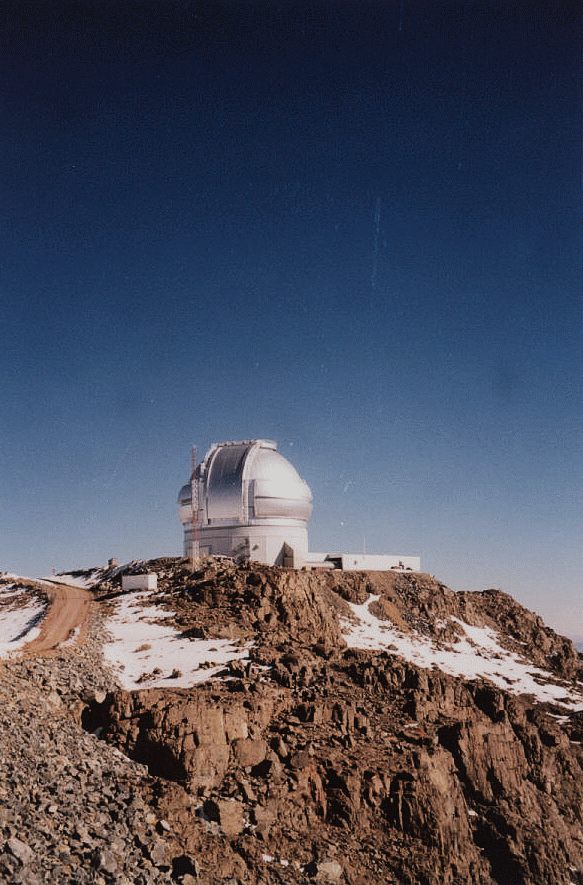 |
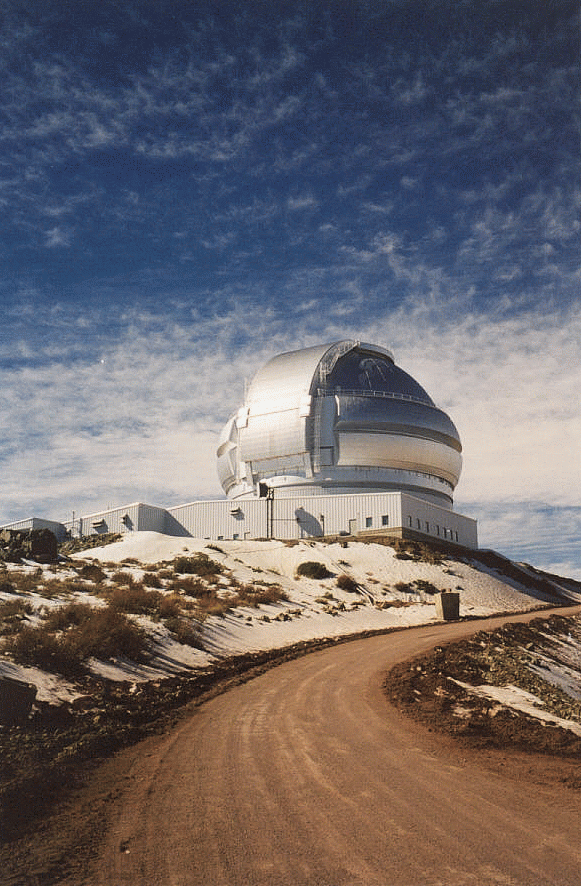 |
 |
 |
I had an invitation from the Gemini South Associate Director Phil Puxley
to join the Science
Staff of the observatory in semester 2001B, to help in several aspects:
This opportunity appeared when it was decided to look for volunteers to help the Science Staff during the first semester when queued observations would take place on Gemini South. The Brazilian National Gemini Office then decided that this would be a great opportunity for a graduate student to gather experience with an 8 meter class telescope; and I was selected to go. Of course, the operation of such a telescope is tremendously complex, so that it takes several months for one to become more familiarized with it. I have participated in the commissioning of the telescope and of some instruments, as well as in many other activities, but my contribution was only a small bit in a very much larger and complex process. In the following, I will summarize my activities in Chile, always referring to more detailed pages when there is one.Commissioning of the telescope; Commissioning of some instruments, the Acquisition Camera, Abu and Flamingos-I; Processing of near infrared Abu data; Phase II planning on scheduled programs; Acquisition and processing of data for the queue Flamingos-I programs.
During the commissioning of the telescope I worked on several tests,
whose main goals are to put all the telescope systems working properly
and reach optimal performance. Some of these tests are:
 Wave
front sensing test - The Gemini telescopes also have a High Resolution
Wave Front Sensor (HRWFS) which provides a more detailed response than
the PWFS. This sensor is used to set up the primary mirror figure in the
beginning of each night. However, the HRWFS is located on-axis (while the
2 PWFS are off-axis), so that it will not be used while doing science observations.
It is necessary to check and compare how the HRWFS and the PWFS are correcting
the primary mirror figure through the actuators. Both must apply the same
correction in order to maximize image quality when doing science. Thus,
it is necessary to model the response of the PWFS, compared to the response
of the HRWFS, for different elevations, probe arm angles and guide star
magnitudes, for instance. This modeling uses the Zernike
polynomials, and the astigmatism correction was one of the main concerns.
This is a very important test, since only with the WFS working properly
Gemini will provide excellent image quality, even comparable to the image
quality attained in HST observations,
with the advantage of a very much larger mirror ground based.
Wave
front sensing test - The Gemini telescopes also have a High Resolution
Wave Front Sensor (HRWFS) which provides a more detailed response than
the PWFS. This sensor is used to set up the primary mirror figure in the
beginning of each night. However, the HRWFS is located on-axis (while the
2 PWFS are off-axis), so that it will not be used while doing science observations.
It is necessary to check and compare how the HRWFS and the PWFS are correcting
the primary mirror figure through the actuators. Both must apply the same
correction in order to maximize image quality when doing science. Thus,
it is necessary to model the response of the PWFS, compared to the response
of the HRWFS, for different elevations, probe arm angles and guide star
magnitudes, for instance. This modeling uses the Zernike
polynomials, and the astigmatism correction was one of the main concerns.
This is a very important test, since only with the WFS working properly
Gemini will provide excellent image quality, even comparable to the image
quality attained in HST observations,
with the advantage of a very much larger mirror ground based.
Processing of Near Infrared Data
With Abu, several objects were imaged in the near infrared bands J,
H, K, L, Br-alpha and Br-gamma. Among the very interesting objects there
are star forming regions, galaxies, globular and open stellar clusters,
and planetary nebulae. All these images were reduced under the Gemini IRAF
packages QUIRC and GEMTOOLS. Reduction procedures include:
Some of the images are:
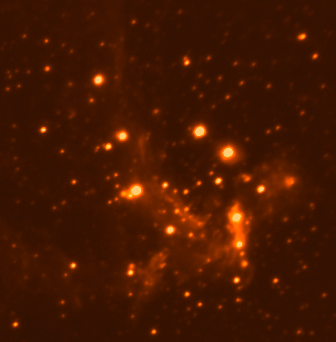 |
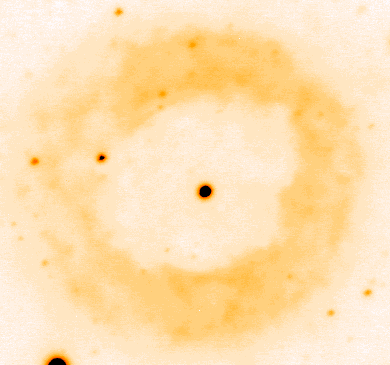 |
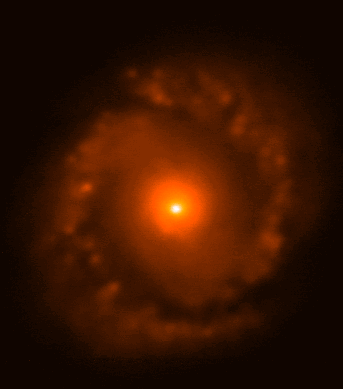 |
Another very interesting Abu image (of the Circinus galaxy) can be found
here.
After one submit an observing proposal (a process called Phase I), and
before the observations take place, a series of processes occur, which
are globally called Phase II. In Phase II, all the details concerning the
observations of an approved observing program are revised by the contact
scientist. Among these details, one can cite:
All this information must also be checked to be in agreement with
what the PI (principal investigator) wants to do with the data acquired,
what the PI is expecting from the data, and what is the science proposed
to do with it. I had the opportunity to help in several approved programs
with the Acquisition Camera and with Flamingos-I, including imaging and
spectroscopy, and programs related to targets of opportunity.
 One
important thing to do in Phase II is use the Observing Tool (OT) to verify
whether or not certain parameters are correct. The OT simulates an observation,
as well as a whole observational program. The figure at left is a snapshot
of one of the windows from the OT. It shows how the image of NGC 1097 above
was acquired. At right, one can see the PWFS1 probe arm, the guide star
used and the vignetting the arm produces. One must be sure that the vignetting
does not affect the instrument's field of view. The square in the center
is the field of view of the Acquisition Camera (2 x 2 arcminutes). The
outer circle shows the outer limits for guide stars.
One
important thing to do in Phase II is use the Observing Tool (OT) to verify
whether or not certain parameters are correct. The OT simulates an observation,
as well as a whole observational program. The figure at left is a snapshot
of one of the windows from the OT. It shows how the image of NGC 1097 above
was acquired. At right, one can see the PWFS1 probe arm, the guide star
used and the vignetting the arm produces. One must be sure that the vignetting
does not affect the instrument's field of view. The square in the center
is the field of view of the Acquisition Camera (2 x 2 arcminutes). The
outer circle shows the outer limits for guide stars.
Data Acquisition and Processing for Flamingos-I Programs
That was the main reason for me to come help the science staff, namely, to acquire and reduce data for the approved programs for queue observations with Flamingos-I in semester 2001B. As said above, a number of unhappy facts prevented us to start the queued programs as scheduled, but finally these were started in the first week of October. Since in the commissioning only the imaging mode could be verified, all spectroscopy programs were excluded, which means four programs, since, with the shortened schedule, it was realized that only programs for bands 1 and 2 could be started.
In the observing runs I have participated, we have imaged distant galaxies (one at redshift 3!), dwarf galaxies, quasars, Lyman break galaxies, very faint stars in star forming regions, and halo white dwarfs. In the first runs we chose the most simple programs for us to be more familiarized with all the processes. In two or three nights we were already able to start more complex programs, involving complicated dithering modes and/or a high number of different objects and observations. Then we chose programs from their ranking band, observing constraints, and whether or not they have been started, need more observations, or have already being applied for the total allocated time.
Data were reduced on-line, either at the control room in Cerro Pachón, or at the computer room in La Serena. In the last case we were connected with Cerro Pachón through video conference the whole night. Obviously, since we were doing that for the first time for Gemini South, data processors could not finish to reduce one night's data at the end of the night! The pipeline reduction is still being developed, the tasks and scripts still being written, so there are still many things to be implemented until data processing can occur in a most efficient way. Data processors have four tasks to accomplish during the night:
Acknowledgments
I would like to thank Dr. Phil Puxley and the Brazilian National Gemini Office for this splendid opportunity, and all the Gemini South Science Staff for making my stay in La Serena a most fruitful and enjoyable time.